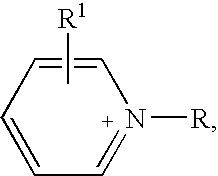Process for removing polar impurities from hydrocarbons and mixtures of hydrocarbons
a technology of hydrocarbons and impurities, which is applied in the direction of hydrocarbon preparation catalysts, extraction purification/separation, and process separation, etc., can solve the problems of limiting the usefulness of hydrocarbons and hydrocarbon mixtures, affecting the removal efficiency of polar impurities, etc., to achieve the effect of mild process conditions and high removal efficiency
- Summary
- Abstract
- Description
- Claims
- Application Information
AI Technical Summary
Benefits of technology
Problems solved by technology
Method used
Image
Examples
example 1
Desulfurization of a Hydrocarbon by Removal of a Sulfur-Containing Impurity
[0073]The following general procedure is used for the desulfurization of a hydrocarbon.
[0074]A hydrocarbon liquid comprising a sulfur-containing impurity is exposed to an ionic liquid according to the invention while agitating the mixture. Following a sufficient period of time for the ionic liquid to extract at least a portion of the sulfur-containing impurity from the hydrocarbon and following phase separation of the mixture of ionic liquid and hydrocarbon, the phases are physically separated from each other. The ionic liquid phase now comprises the sulfur-containing impurity and the hydrocarbon comprises a reduced amount of or no detectable amount of the impurity. The mass ratio of ionic liquid to hydrocarbon can vary widely but is generally in the range of about 1:1,000,000 to 999:1. Variation of the molar or weight ratio will depend upon the identity and physical properties of the hydrocarbon and ionic li...
example 2
Exemplary Ionic Liquids of the Invention
[0075]An ionic liquid according to the invention is defined as a compound or mixture of compounds of the Formula 1 (A)n+(Y)n−. Exemplary ionic liquids according to the invention include, by way of example and without limitation (a) 1-Butyl-3-methylimidazolium tetrachloroaluminate; (b) 1-ethyl-3-methylimidazolium tetrachloroaluminate; (c) diethylcyclohexylammonium methanesulfonate / tributylammonium methylmethanesulfonate; (d) dodecyltrimethylammonium tetrachloroaluminate; (e) trioctylmethylammonium tetrachloroaluminate; (f) diethylmethylcyclohexylammonium methansulfonate / tributylmethylammonium methanesulfonate; (g) 1-butyl-3-methylimidazolium BTA; and (h) 1,3-dimethylimidazolium methanesulfonate.
example 3
Desulfurization of N-Dodecane by Removal of Dibenzothiophene
[0076]The following general procedure is used for the desulfurization of n-dodecane. A solution comprising dibenzothiophene (present at a concentration of 500 ppm) dissolved in n-dodecane is provided. The n-dodecane is treated with an ionic liquid (selected from those of Example 2: (a) through (h)) by employing a single extraction. A mass ratio of 1 to 5 (ionic liquid: n-dodecane) was used. Mixing was conducted for 15 minutes at room temperature or at 60° C. in the case of (c) and (f) since these are solids at room temperature. The n-dodecane was separated from the two-phase mixture, and the sulfur content determined by combustion analysis. The chemical structure of some of the ionic liquids employed is show below. Below each structure is the concentration of dibenzothiophene remaining in the n-dodecane after the single extraction.
[0077]
PUM
| Property | Measurement | Unit |
|---|---|---|
| temperature | aaaaa | aaaaa |
| pH | aaaaa | aaaaa |
| temperature | aaaaa | aaaaa |
Abstract
Description
Claims
Application Information
 Login to View More
Login to View More - R&D
- Intellectual Property
- Life Sciences
- Materials
- Tech Scout
- Unparalleled Data Quality
- Higher Quality Content
- 60% Fewer Hallucinations
Browse by: Latest US Patents, China's latest patents, Technical Efficacy Thesaurus, Application Domain, Technology Topic, Popular Technical Reports.
© 2025 PatSnap. All rights reserved.Legal|Privacy policy|Modern Slavery Act Transparency Statement|Sitemap|About US| Contact US: help@patsnap.com



